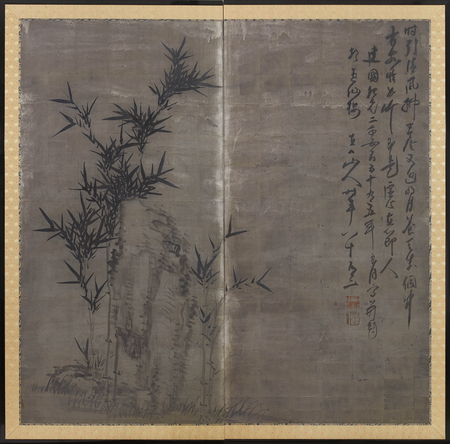Product Description
7138 A two-fold paper screen painted in ink on a silver ground with a rock, bamboo and calligraphy.
Inscribed: I painted at the time when the pure breeze is felt under the willow tree and the bright moon. The bamboo is upright and impartial like a righteous man. 10th Month of the beautiful moon in the Imperial Calendar year of 2555*. Painted at the Studio of the Five Immortals.
Signed: Chokunyū sanjin hitsu hachijūni (Inscribed and painted by Chokunyū, at the age of 82*)
Seals:
Right: Bōsai
Left, upper: Ta-chi no in
Left, lower: Kozetsu shi
Japan 19th century Meiji period *1895
Dimensions: H. 159cm x W. 162cm (62¾” x 64”)
Tanomura Chokunyū (1814-1907) Gō (art name): Chokunyū, Incha Shujin, Ryūō (Kasaō), Sanshō, Seiwan, Seiwan Gyorō, Shōko, Shōko Sanjin. Born in Bungo Province Chokunyū was a nanga (Chinese style) painter, calligrapher and poet who lived and worked in Kyoto. He was the pupil and adopted son of Tanomura Chikuden (1777-1835) and as part of his artistic training he copied late Chinese painting. He was a key person in establishing the Kyōto Munincipal School of Fine Arts and Crafts and was its first director before leaving to co-found the Nihon Nanga Kyōkai (Japan Nanga Society) in 1896 with Tomioka Tessai (1837-1924). Chokunyū was a leading exponent of the nanga tradition in the Meiji era with many pupils and served a juror for many exhibitions.
Works by the artist can be found in the collections of: Ashmolean Museum, Oxford; British Museum, London; Idemitsu Art Gallery, Tokyo; Museum of Fine Arts, Boston;Yamatane Museum of Art, Tokyo.
Take (bamboo) in Taoism and to a lesser extent in Buddhism symbolises the notion of emptiness, this is due to the tube-like structure of the bamboo. Just as the tao (the ineffable ‘way’ of Taoism) arises from nothing and returns to emptiness, the bamboo is empty at its core. In East Asian philosophy such emptiness is perceived in a positive rather than a negative light. It is also a symbol of purification.
Haiku by Otagaki Rengetsu (1791-1875)
This gentleman
Grows and grows
Most auspiciously
Learn from him and
You, too, will flourish for ever.
Written at the age of 80 (1870)









